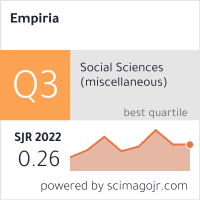Networked analysis of coincidences
DOI:
https://doi.org/10.5944/empiria.39.2018.20879Keywords:
statistical analysis, social networks analysis, interactiv visual statistics, coincidences, graphsAbstract
The goal of this paper is the proposal of a new framework for the study of data structures based on the combination of several types of multivariate and social network analysis. By means of these techniques we obtain the most frequent events in a given set of scenarios as well as those events that tend to occur with them. In this respect we can define several coincidence gradients for the events under study. Ranging from zero to total coincidence and passing through statistically probable coincidences with predetermined confidence levels. The appearance structure of the set of events studied according to the selected coincidence gradient can be conveniently represented by a graph. In addition to its rationale, three free software programs are shown so that any user could apply this framework: coin, netcoin and webcoin. This type of procedure can be applied to the exploratory analysis of questionnaires, to the study of semantic networks, to the revision of databases and even to the comparison of different techniques of statistical analysis of interdependence. This is made posible by using factorial and classificatory methods and different methods for representing graphs based on attraction-repulsion forces, like those of Fruchterman-Reingold and Kamada-Kawai.











